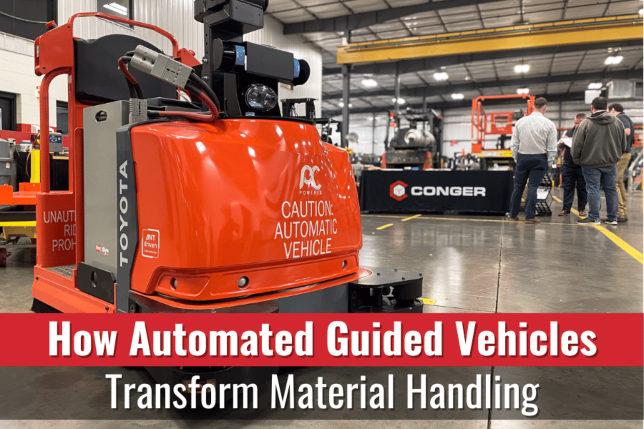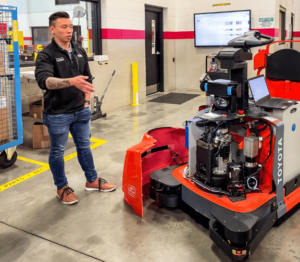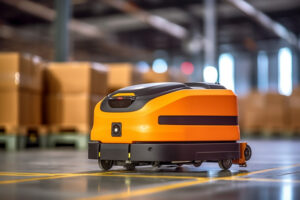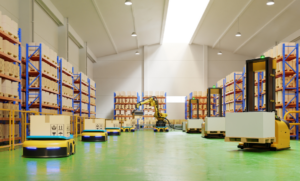Imagine getting into your car each day and having it drive itself. No more stressing over rush hour; just sit back as your smart vehicle takes care of everything. With the rise of automated guided vehicles, or AGVs, companies now handle goods inside their warehouses and production lines faster and more efficiently than ever before.
Automated machines are stepping in for some manual labor and forklifts, streamlining material movement with greater efficiency and safety. This shift is transforming the way industries operate.
Imagine a warehouse where robots handle routine jobs efficiently. That’s what happens with AGVs—they minimize errors made by people, cut labor expenses drastically, and set impressive benchmarks for getting work done safely.
Want to learn more?
Understanding Automated Guided Vehicles (AGVs)
What is an AGV?
An Automated Guided Vehicle (AGV) is a portable robot that follows along marked long lines or wires on the floor or uses radio waves, vision cameras, magnets, or lasers for navigation.
Factories and warehouse environments frequently rely on them to shift hefty loads across various parts of their facilities.
As part of a broader automation strategy that includes IoT devices and smart system integration—AGVs help create truly interconnected facilities capable of unprecedented levels of productivity and adaptability.
The Evolution of Driverless Vehicles
The journey from the first AGV developed by Barrett Electronics back in the 50s to the high-tech wonders they are today is nothing short of remarkable.
They have evolved from simple tow trucks following wires on the floor to smart-tech machines navigating complex environments with lasers and cameras.
- 1950s: The birth of AGVs as simple, wire-following vehicles.
- Late 20th Century: Tech upgrades bring more autonomy as they utilize lasers for navigation.
- 21st Century: Enter AI and machine learning, taking AGVs to a new level of intelligence.
AGV vs. AMR: Navigating the Differences
You might hear about Autonomous Mobile Robots (AMRs) when talking about automated transporters. So what is the difference? Flexibility and smarts distinguish them, as AMRs can improvise their moves using sophisticated sensors and artificial intelligence, eliminating the need for set routes. While both aim to shift stuff around without human help, AMRs are akin to geniuses that can adapt on the fly thanks to advanced sensors and AI algorithms—no predefined paths are needed here.
Key differences include:
- Navigation Capabilities:
- AGVs stick to defined routes marked by wires or tapes.
- AMRs maneuver through spaces dynamically, avoiding obstacles in real time.
The Benefits of Implementing AGVs in Your Operations
Enhancing Workplace Safety
AGVs offer numerous benefits but let’s first talk about safety because what is more important? Automated Guided Vehicles (AGVs) are the quiet heroes of the factory floor or warehouse.
With their careful planning to sidestep issues, processes go off without trouble. As a result, there’s greater safety overall with reduced accident rates.
With AGVs managing routine chores, there’s less risk of injuries from things like lifting too much or making slip-ups at work.
Boosting Operational Efficiency
AGVs excel in efficiency, outperforming even the most experienced workers by autonomously transporting materials across distribution centers or delivering parts directly to manufacturing assembly lines. Their precision ensures operations continue seamlessly, moving goods effortlessly over long distances without downtime.
This unwavering consistency accelerates tasks and guarantees 24/7 reliability—no need for coffee breaks.
Reducing Labor Costs and Environmental Impact
- Labor costs: Labor is not getting any cheaper. By replacing manual transport tasks with AGVs, companies can significantly reduce ongoing expenses associated with staffing, such as salaries and benefits packages.
- Eco-friendly vibes: AGVs help lower emissions within your operation since they typically run on clean energy sources like batteries instead of fossil fuels.
If you want to see these AGV’s in person we are now offering demos at our Green Bay location. Contact us for more information.
Components and Types of AGVs
Core Components of AGVs
These systems rely on these components for their functionality:
1. Navigational Technology: AGVs use advanced technologies like laser guidance, magnetic paths, and vision-based systems to navigate accurately through environments, ensuring task completion without human help.
2. Battery Systems & Charging Solutions: AGVs are powered by lithium-ion or lead-acid batteries, with the choice depending on operational needs and budget. Featuring modern opportunity chargers that allow swift recharges during short rests or pauses means these systems help keep vehicle fleets operating continuously with minimal interruption.
3. Safety Features & Sensors: With sensors and safety mechanisms like proximity sensors and emergency stop buttons, AGVs can prevent accidents in workspaces shared with humans. Advanced scanners provide extensive hazard detection around the vehicle to ensure both product integrity and worker safety.
Exploring Different Types of AGVs
Just as cars come in various models to suit different needs, so do automated guided vehicles. Here is a quick look at some types you might meet on your next factory tour.
- Towing AGVs haul materials from one spot to another using precise navigation systems—no human intervention needed—which speeds up operations significantly. For companies involved in making cars or producing paper, using powerful rigs to tow several trailers reduces both travel time and manpower needed for transporting goods across great distances.
- Unit load carriers excel in operations needing precise transportation of pallets or bins, optimizing processes without human intervention—ideal for hygiene and accuracy-critical areas such as food processing or pharmaceuticals.
- Forklift AGVs merge traditional lifting abilities with autonomous technology, allowing for stacking goods at heights and precision rack access—key in maximizing storage space while ensuring high operational speed in warehousing.
- Light load transporters cater to smaller loads requiring swift movement in tight spaces, perfect for places like electronics assembly lines or hospitals where space is limited but efficiency is crucial.
When companies use various AGVs, they streamline repetitive work and make operations run smoother without much effort from employees.
Key Takeaway:
Utilizing modern tech advancements like efficient batteries and precision guidance systems coupled with solid safety standards makes sure that AGVs effectively protect your products as well as staff members. Tailored into multiple designs, these automated vehicles support businesses by taking over repetitive jobs while fitting neatly into any operation’s distinct workflow.
AGV Navigation Technology
How Do AGVs Navigate?
Automated Guided Vehicles use a mix of lasers, cameras, and sometimes even magnets to find their way. Picture them as video game characters who know exactly where the treasure is but also need to dodge obstacles.
At their core, these machines operate with a singular purpose: to navigate from point A to point B smoothly. They achieve this by adhering to predetermined paths outlined on the ground or responding to wireless signals. Essentially, AGVs follow an invisible map that only they can interpret.
Advanced Navigation Technologies for Enhanced Performance
The age of AGVs relying on magnetic tape is phasing out. For navigating outside areas today, they’re equipped with high-tech gadgets like LiDAR and GPS. Clever software handles all the calculations effortlessly. Robots now follow preset paths and can quickly change direction on the fly when needed.
- LiDAR: This technology uses light sensors to measure distances and navigate around obstacles. Think of it as echolocation but with lasers.
- Inertial Guidance Systems: By utilizing gyroscopes and accelerometers, these systems help keep AGVs on track even when external cues might be lacking.
- Vision-Based Navigation: A vision system that uses cameras to analyze surroundings and dynamically adapt pathways.
Key Takeaway:
These days, automated guided vehicles use a mix of traditional concepts and modern advancements, allowing them to be very adaptable and smart. They can strategically plan and improvise their paths in real time, ensuring the efficient movement of goods through facilities without human intervention.
Choosing the Right AGV Solution for Your Needs
To truly ramp up efficiency, businesses need to find just the right automated guided vehicle that fits their needs perfectly. The abundance of choices might seem daunting at first; however, identifying crucial aspects streamlines your decision-making process considerably.
Understanding Your Operational Requirements
The first step in choosing an AGV system is comprehensively analyzing your operational needs. Consider the types of materials you need to move, their weight, and dimensions. Review your space setup closely, noting how wide aisles are and identifying any obstacles that might make moving around difficult. This first step will help you figure out which AGV best suits your space.
Customization Options for Specific Industry Needs
Manufacturing Sector Solutions
The manufacturing sector demands precision, efficiency, and reliability in its operations. Customizable features such as payload capacity adjustments ensure that whether you are dealing with delicate electronics or heavy machinery parts, there is an AGV solution.
Distribution Centers: Streamlining Operations
In distribution centers where time is of the essence, AGVs equipped with advanced navigation systems can significantly reduce order fulfillment times by optimizing picking routes and ensuring accurate delivery of goods within sprawling warehouses. The adaptability of these vehicles allows for easy scalability – essential in industries experiencing rapid growth or seasonal fluctuations.
Food Processing/Storage Industry Innovations
Ensuring spotless facilities while keeping precise temperature levels can be tough in the food processing and storage sector. Custom AGVs are advantageous in this sector as they can navigate cold storage conditions efficiently while maintaining the high hygiene standards required to avoid contamination during product transport.
Key Takeaway:
Choosing the best AGV for your operational needs isn’t just a smart move; it makes everything from safety to productivity work better together. You will want to think about the kinds of materials you’re using, understand their properties well, and plan your workspace layout for optimal results. Evaluating an AGV setup makes sure you find one that fits perfectly with how your operation runs.
Ensuring Safety and Compliance in the Workplace
In fields like manufacturing or food processing where every second counts for productivity—and accidents can cost more than just time—keeping up with safety standards isn’t optional; it’s essential for smooth operations. With the addition of AGVs, not only do we improve our overall safety measures but we also stay compliant with all necessary regulations without hassle.
The Role of AGVs in Improving Safety
Automated Guided Vehicles are revolutionizing material handling across various industries. By automating routine or hazardous material handling tasks, AGVs significantly reduce the risk of workplace accidents often seen in manufacturing facilities. This automation safeguards employees and enhances productivity by allowing human resources to focus on more critical operations.
- Risk Reduction: With precise movements and programmed routes, AGVs minimize incidents of collisions or mishandling that can lead to injuries or damage.
- Error Minimization: Automated systems decrease human errors that can contribute to unsafe work conditions.
- Ergonomic Benefits: Reducing manual lifting and carrying reduces strain-related injuries among workers.
Navigating Safety Requirements with Technology
To remain compliant with evolving safety regulations within their respective industries, companies must continuously seek innovative solutions like AGV technology. Implementing these advanced systems demonstrates a commitment to improving the safety protocols crucial for passing regulatory inspections and avoiding costly fines associated with non-compliance issues. Moreover,
- Safety Audits & Inspections: A thorough history of employing automated gear like AGVs not only makes auditing easier but also showcases dedication to maintaining a secure work environment over time.
- Data-driven Decisions: When we look at the data from AGVs in action, it becomes clear where we can fine-tune our approach to enhance both speed and security measures.
Incorporating Automated Guided Vehicles into your business strategy is more than just an investment in technology—it is an investment in the health and security of your workforce. As we move into an era where technological advancements continue shaping industry landscapes, staying ahead of regulatory curves means embracing tools designed for productivity and safeguarding our most valuable asset: our people.
Key Takeaway:
When businesses choose to use Automated Guided Vehicles, they’re prioritizing worker safety while staying within regulatory guidelines. Modernizing with AGV technology not only ramps up efficiency but also safeguards your team. It’s all about embracing new methods that drive productivity gains while protecting those on the job.
Real-World Applications and Case Studies
Transforming Manufacturing Processes with AGVs
Automated Guided Vehicles (AGVs) have transformed manufacturing and distribution by automating material handling, enhancing efficiency, safety, and scalability. For example, an automotive manufacturer introduced AGVs to streamline assembly line workflows and minimize errors and accidents. Similarly, a pharmaceutical firm employed AGVs for accurate ingredient management in drug production, ensuring quality while meeting regulatory demands.
Streamlining Distribution Center Operations
In distribution centers, AGVs improve picking processes by:
- Picking Efficiency: In distribution centers where time is of the essence, AGVs have been instrumental in streamlining picking processes. These vehicles navigate through aisles autonomously to retrieve items based on digital orders—dramatically increasing order process speed.
- Safety Enhancements: By taking over repetitive or hazardous material handling tasks from humans, AGVs significantly reduce the risk of injuries related to manual labor within distribution environments.
- Eco-friendly Operations: Many modern AGVs are battery-powered with zero emissions during operation—a step towards sustainable practices within warehouses and distribution centers.
Energy Efficiency AGVs are Transforming Manufacturing Logistics
The manufacturing industry has begun prioritizing energy efficiency throughout its operations and broader supply chains. Many companies now use drones and Automated Guided Vehicles alongside older methods to move materials efficiently. This mix helps them save energy while keeping things running smoothly. Imagine your plants running on enhanced coordination between ground-based AGVs and aerial drones – that’s exactly what this breakthrough aims to achieve, refining internal logistic workflows like never before. This combination of AGVs and drones significantly boosts the efficiency of supplying production lines and can reduce energy consumption by up to 30%. When businesses reduce their running costs, they also shrink their carbon footprint. This leads to less pollution from factory activities and a greener planet overall.
Learn more about this case study here
Key Takeaway:
Automated Guided Vehicles (AGVs) are significantly transforming various industries by improving automation and reshaping operations in areas such as a manufacturing facility. Thanks to technological advancements, AGVs are set to become even more integral to worldwide industrial ecosystems.
Overcoming Challenges with AGVs
Addressing High Initial Investment Concerns
Integrating Automated Guided Vehicles in manufacturing, distribution, and food processing significantly enhances efficiency and productivity. Many companies find the initial expense of installing sophisticated material handling equipment quite daunting. Figuring out what’s at stake here will help guide your choices so they’re in sync with with your long-term operational goals.
The high upfront costs may be shocking, but it is essential to consider the total cost of ownership over time rather than just the initial purchase price. Imagine cutting down what you spend on staffing all while making sure your items stay pristine during handling; that’s one benefit of using AGV systems which naturally boosts productivity levels & heightens safety standards at workplaces Checking out different financing options or leasing deals can help you affordably bring AGVs into your business operations.
Another strategy is starting small – implementing a pilot program with a few AGVs allows you to assess their impact on your operations before committing to a full-scale rollout. Managing costs becomes easier when you take it one phase at a time. Plus, you’ll gather important info on enhancing workflow efficiency with tech automation.
Strategies for Achieving Quick ROI
• Cut Down on Labor Costs: AGVs work around the clock without breaks or overtime pay, directly slashing payroll expenses.
• Increase Efficiency and Productivity: AGVs move materials faster than ever. With precise movements and optimized routes.
• Ramp-Up Safety Measures: Fewer accidents mean less downtime and cost savings on compensation claims.
• Eco-friendly Operations: Many AGVs run on electric power sources, reducing emissions and potentially lowering energy bills.
A quick win is within reach if you strategize right from the start. Sure, there is an upfront investment when bringing AGVs into your workflow – but think of them as not just machines but as investments in your future. The bottom line? Those reduced labor costs combined with increased efficiency catapult operational performance sky-high while fast-tracking return on investment (ROI).
Managing Maintenance
Maintenance is another critical aspect often overlooked when considering an investment in AGV technology. Regular maintenance ensures these vehicles operate at peak performance levels while extending their service life significantly.
- Routine Inspections: Scheduled inspections help identify potential issues before they become costly repairs or downtime.
- Software Updates: Keeping software up-to-date ensures that each vehicle operates efficiently and benefits from the latest features and security enhancements.
Incorporating predictive maintenance strategies through IoT (Internet of Things) technologies further enhances reliability by monitoring vehicle health in real time and predicting failures before they occur. Engaging with reputable material handling equipment providers who offer comprehensive after-sales support, such as regular maintenance service and training for your staff on basic troubleshooting, can also alleviate managing concerns related to these sophisticated systems.
Key Takeaway:
Using Automated Guided Vehicles in factories and warehouses brings both benefits and obstacles. When addressing investment concerns and maintenance needs from the start, it becomes easier to weave new strategies into daily routines. The result? Better performance across the board without straining resources or endangering employees.
Conclusion
With the rise of automated guided vehicles (AGVs), work environments have become more streamlined, handling jobs with greater precision and speed. Enhancing overall safety and performance, these automated systems replace many tasks once done by hand. Their continuous operation significantly lowers the chances of mistakes or injuries happening. Introducing AGVs into operations is like hitting two birds with one stone – they trim expenses and enhance productivity at the same time. Contrary to the Hollywood portrayal of AI, AGVs exemplify how technology can transform our reality by seamlessly integrating into industrial processes without overburdening humans. As perceptions change, there’s a growing trend towards adopting smarter workplaces designed for higher efficiency moving forward.










